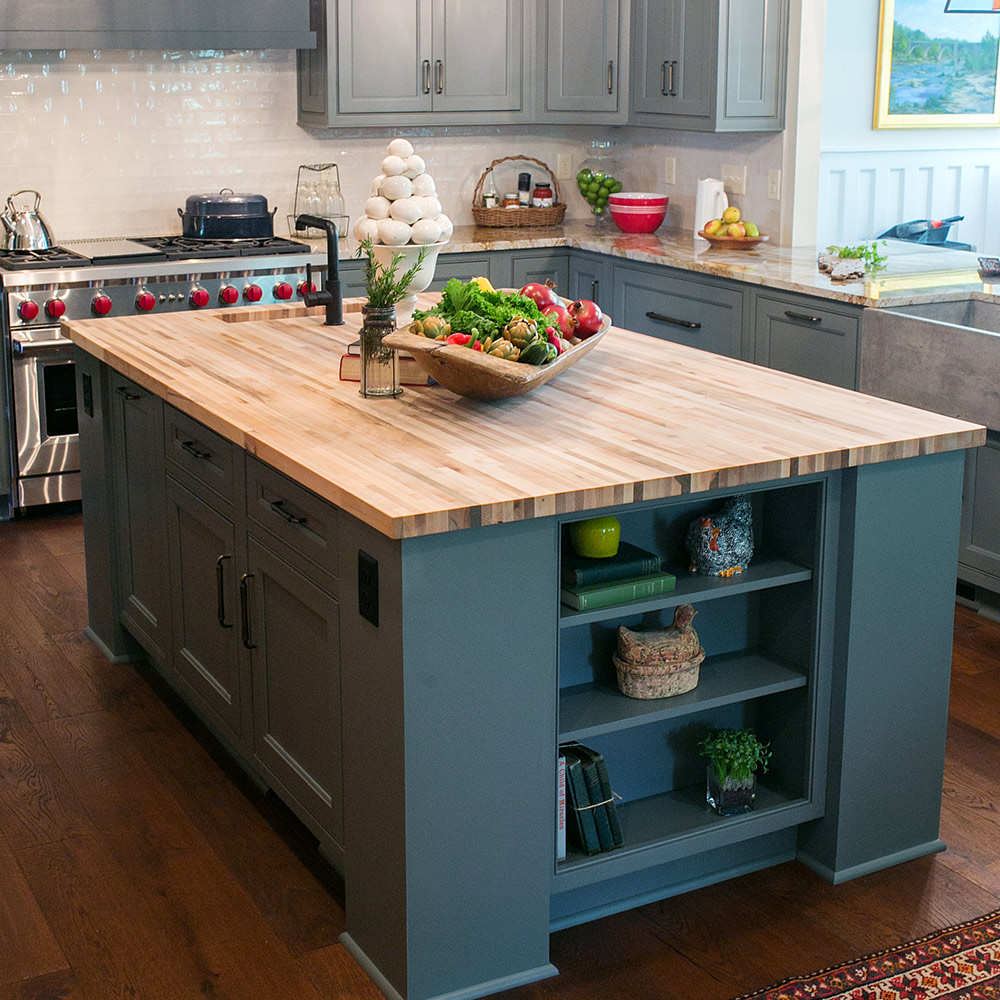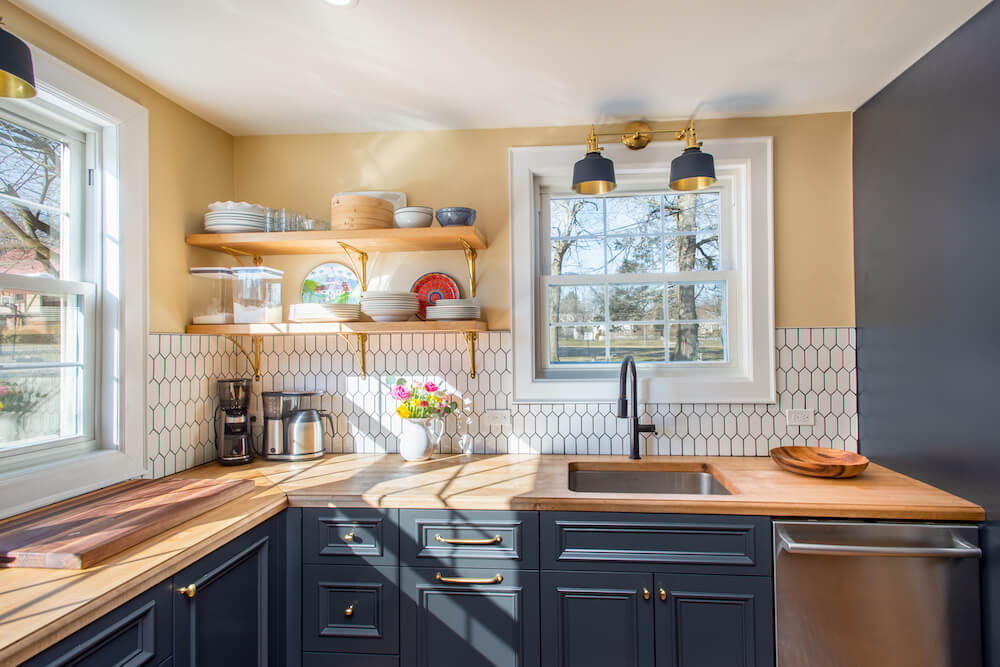Color Combinations for Butcher Block Countertops: What Color Cabinets With Butcher Block Countertops

Butcher block countertops, known for their durability and rustic charm, offer a unique canvas for creating a visually appealing kitchen. Their natural wood grain adds warmth and character, making them compatible with a wide range of cabinet colors.
Warm Neutrals
Warm neutral colors, such as cream, beige, and light brown, create a cozy and inviting atmosphere. These colors complement the natural tones of butcher block, enhancing its warmth and creating a harmonious balance.
- Cream cabinets with a matte finish create a classic and timeless look, while light brown cabinets with a distressed finish add a touch of rustic charm.
- Beige cabinets, particularly in a soft, muted shade, provide a subtle backdrop that allows the butcher block to take center stage.
Cool Grays
Cool grays, ranging from soft dove gray to charcoal, provide a modern and sophisticated contrast to the warm tones of butcher block. This combination creates a visually interesting space that is both elegant and functional.
- Light gray cabinets with a satin finish create a clean and airy feel, while dark gray cabinets with a high-gloss finish add a touch of drama.
- Cool gray cabinets with a textured finish add depth and dimension, complementing the natural grain of the butcher block.
Bold Accents
Adding a splash of color with bold accents can create a vibrant and energetic kitchen. This approach allows for a more personalized touch and adds a unique focal point to the space.
- Blue cabinets, especially in shades of teal or navy, create a calming and sophisticated atmosphere.
- Green cabinets, in shades of sage or emerald, bring a touch of nature indoors, complementing the natural wood tones of the butcher block.
- Red cabinets, particularly in a deep burgundy or cherry red, add a touch of warmth and vibrancy, creating a bold statement in the kitchen.
Impact of Wood Tones
The wood tone of the butcher block plays a significant role in determining the overall color scheme.
- Light-toned butcher block, such as maple or birch, creates a bright and airy feel, complementing lighter cabinet colors.
- Medium-toned butcher block, such as oak or cherry, provides a warm and inviting ambiance, pairing well with both light and dark cabinets.
- Dark-toned butcher block, such as walnut or mahogany, creates a rich and sophisticated look, often paired with darker cabinet colors.
Cabinet Finishes
The finish of the cabinets can significantly impact the final look of the kitchen.
- Painted cabinets offer a clean and modern look, allowing for a wide range of colors and finishes.
- Stained cabinets provide a more traditional and rustic feel, enhancing the natural wood grain.
- Distressed cabinets add a touch of vintage charm, creating a cozy and inviting atmosphere.
Cabinet Styles for Butcher Block Countertops

Butcher block countertops, with their rustic charm and durability, lend themselves well to various cabinet styles. The choice of cabinet style can significantly influence the overall aesthetic of your kitchen, from creating a cozy farmhouse feel to a sleek and modern vibe. This section explores the harmonious blend of butcher block countertops with different cabinet styles, highlighting their advantages and disadvantages.
Cabinet Styles for Butcher Block Countertops
| Style | Pros | Cons | Design Elements |
|---|---|---|---|
| Farmhouse |
|
|
|
| Modern |
|
|
|
| Traditional |
|
|
|
| Contemporary |
|
|
|
Design Considerations for Butcher Block Countertops

Butcher block countertops, known for their rustic charm and durability, offer a unique blend of practicality and aesthetics. When incorporating butcher block into your kitchen design, several factors come into play, influencing both the functionality and visual appeal of your space.
Durability and Maintenance
Butcher block countertops are renowned for their resilience, but they require consistent care to maintain their beauty and longevity.
- Regular Oil Treatment: Butcher block surfaces need regular oiling to prevent dryness and cracking. Applying mineral oil or butcher block conditioner every few months helps replenish the wood’s natural oils, ensuring a smooth, water-resistant finish.
- Cleaning: Gentle cleaning with mild soap and water is recommended. Avoid harsh chemicals or abrasive cleaners, as these can damage the wood’s surface.
- Staining: While butcher block is naturally resistant to stains, spills should be addressed promptly. Use a damp cloth to wipe up spills immediately and consider applying a sealant to enhance stain resistance.
Kitchen Size and Shape
The size and shape of your kitchen play a significant role in determining the best placement and design of butcher block countertops.
- Smaller Kitchens: In compact kitchens, butcher block can create a warm and inviting atmosphere. Consider using smaller sections of butcher block for accent areas, like a breakfast bar or a small island, to maximize space and avoid overwhelming the room.
- Larger Kitchens: Larger kitchens allow for more expansive butcher block countertops, creating a statement piece. Consider using butcher block for a large island or a continuous countertop along the perimeter, showcasing its natural beauty and functionality.
Creating a Cohesive Design
A well-designed kitchen blends functionality and aesthetics seamlessly. Butcher block countertops can be incorporated into various styles, adding warmth and character to your space.
- Color Palette: Butcher block’s natural wood tones complement a wide range of color palettes. Consider pairing it with neutral colors like white, gray, or black for a classic look. For a bolder statement, opt for vibrant hues that contrast with the wood’s warmth.
- Cabinetry: Choose cabinet styles that complement the rustic charm of butcher block. Shaker cabinets with simple lines and clean finishes provide a timeless backdrop for butcher block’s natural beauty. Consider painted cabinets in colors that harmonize with the wood tones for a cohesive look.
Lighting and Backsplash Choices, What color cabinets with butcher block countertops
Lighting and backsplash choices can significantly enhance the beauty and functionality of butcher block countertops.
- Lighting: Adequate lighting is essential for showcasing the natural grain and texture of butcher block. Consider using a combination of overhead lighting and under-cabinet lighting to illuminate the countertop surface evenly.
- Backsplash: The backsplash acts as a visual backdrop for the countertops. Choose a backsplash material that complements the butcher block’s natural warmth. Subtle tile patterns or a solid-colored backsplash can create a clean and modern look. For a more rustic feel, consider using natural stone or brick.
What color cabinets with butcher block countertops – The warm tones of butcher block countertops can be a beautiful complement to a variety of cabinet colors, from rich browns to crisp whites. While white cabinets with gray countertops are a classic choice for bathrooms, as seen in this design guide white cabinets gray countertops bathroom , in a kitchen, a butcher block countertop can add a touch of rustic charm and warmth to a space.
When paired with white cabinets, the butcher block provides a striking contrast, highlighting the clean lines of the cabinets and creating a balanced and inviting atmosphere.
While the warmth of butcher block countertops pairs beautifully with a variety of cabinet colors, for a truly modern aesthetic, consider the sleek contrast of black kitchen cabinets. The stark lines of black cabinetry are accentuated by the cool, industrial feel of concrete countertops, creating a sophisticated and minimalist space.
If you’re looking for a more contemporary approach to kitchen design, exploring the possibilities of black kitchen cabinets with concrete countertops might be the perfect way to achieve a bold and timeless look. Of course, for those who prefer a more traditional feel, the classic combination of butcher block and warm wood tones remains a timeless choice.